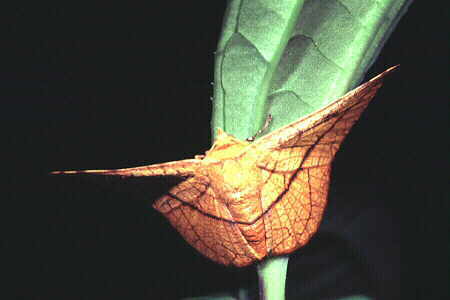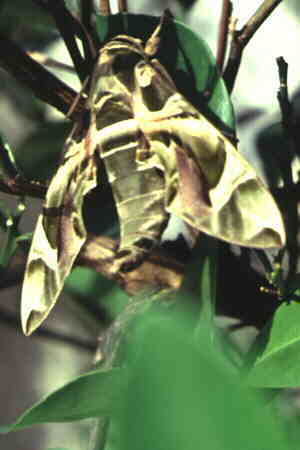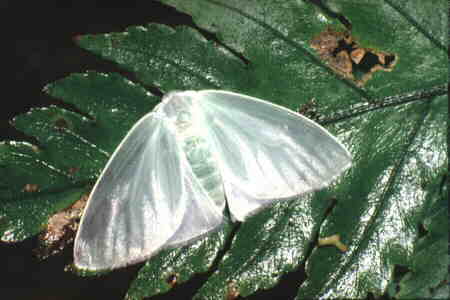|
CHIN'S NATURE CORNER ~ PHOTO GALLERY ~ MALAYSIAN MOTHS PAGE 1
|
Malaysian Moths
 MOTHS are generally dull coloured and fly at night, and are seldom noticed. But there
are moths which are colourful, like the spectacular Atlas Moth above, and moths which
are diurnal in habit.
This section of the Picture Gallery displays some moths
that I have encountered while out looking for butterflies. They were photographed in a
by-the-way manner only when I happened to see them. Butterflies are still my main
interest as photography
subjects.
MOTHS are generally dull coloured and fly at night, and are seldom noticed. But there
are moths which are colourful, like the spectacular Atlas Moth above, and moths which
are diurnal in habit.
This section of the Picture Gallery displays some moths
that I have encountered while out looking for butterflies. They were photographed in a
by-the-way manner only when I happened to see them. Butterflies are still my main
interest as photography
subjects.
While I have many reference books on Malaysian butterflies, my resources on moths are
rather limited. If you can identify the species shown here, particularly those at
the bottom of the page, I would be happy if you will kindly let me know the name of the
species, or email me if I've got the identification or facts wrong.
Please click on either the thumbnail image or the name of the species to see a bigger
picture of the moth (or larva, in some cases). The picture opens in a new window.
You can navigate to a limited extent within that window.
After viewing it, close that window to return to this page.
|
Family Thyrididae

|
Telchines vialis is a leaf-mimicking moth. With many lines on its wings
simulating leaf veins and a golden brown colour, this moth bears some resemblance
to a dead leaf. This species is found in northern India, Malaysia and Indonesia.
|
Family Limacodidae

|
This pretty larva
of a Limacodid moth is armed with spines which can cause a nasty itch. I accidentally brushed my
hand against this caterpillar while trying to photograph an insect, and it left a stinging
sensation for hours on that part of my hand that had touched it.
|
Family Sphingidae

|
Ambulyx (formerly Oxyambulyx) canescens is considered a forest pest because its
larvae feed on the leaves of young Dryobalanops lanceolata, a timber tree. This
hawkmoth is found in Indochina, Malaysia, Sumatra, Java, Borneo and the Philippines.
|

|
The Oleander
Hawkmoth (Daphnis nerii) has a very wide geographical range. This species occurs
in the Afrotropical and Indo-Australian regions, and is known to migrate northwards to Europe.
However, I have seen it only once.
|
Family Arctiidae

|
Nyctemera coleta belongs to a group of day-flying moths known as Marbled
White Moths. It is a common species usually encountered in secondary growth. Besides
Malaysia, it is also found in India, Sri Lanka to south
China, Taiwan, the Philippines and New Guinea.
|

|
Amata
huebneri is regarded as a wasp mimic with the common name of Wasp Moth.
It is a day-flying species about the same size as a small wasp. This species was formerly
known as Syntomis huebneri (subfamily Syntominae).
|

|
This is possibly
Syntomoides (Ceryx) imaon. It is also a wasp mimic but is commonly known as the
Handmaiden Moth. Like Amata huebneri, it is a day-flying species belonging to the
subfamily Syntominae, but it is much larger than the former.
|
Lymantriidae

|
What drew my attention to this white moth is the satin-like gloss on its wings.
This is a
Leucoma sp., possibly impressa. Another completely white moth of
about the same size found in Malaysia is
Chasmina nigropunctata (Noctuidae).
|
Family Noctuidae

|
Othreis smaragdipicta (Catocalinae) is a master of disguise that
blends in perfectly with the detritus and green growth on the forest floor.
Its common name of Yellow Underwing refers to its hindwings which "flash" to startle
a would-be predator when it is disturbed and takes flight.
|

|
Ischyja
inferna (Catocalinae) is a leaf-mimicking moth that prefers to settle on the
forest floor and "hide" among the dead leaves and other detritus. Its disguise would
have been totally effective but for the bit of light blue on the hindwings
which gave the moth away.
|

|
Asota caricae (Aganainae) belongs to a group of moths commonly known as Tiger
Moths. This species has a wide range and is found in the Indo-Australian region. The larval food plant
is Ficus oppositifolia. The species has also been recorded as a pest of papaya.
|
Drepanidae

|
This moth is another leaf mimic. It looks like a dead leaf that has fallen on
a green (living) leaf in the forest understorey. A bit of forest detritus lying next
to it makes the moth's disguise even more realistic. It is a species of
Oreta, possibly bicolor
(subfamily Oretinae).
|
This page revised on 22 May 2005. Copyright © Chin Fah Shin.
|
MOTHS OF
THAILAND
Some time ago, a visitor to my website
Michel Chantraine
sent me some photos of moths that he took Thailand, asking me if I could
help him find out their names. I posted his photos in this section with a
broadcast for help with their identification. I now have a response from an expert.
(Thank you, YSH of Taiwan.) For the photos and IDs of those moth species, please
turn to Moths of Thailand.
|
|












